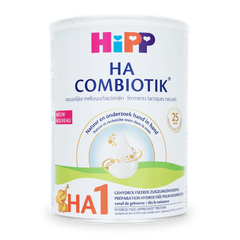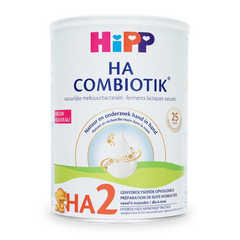Why you should use Hydrolyzed (HypoAllergenic) baby formula?
As a parent, you want to provide the best possible nutrition for your baby. However, finding the right formula can be challenging if your child has allergies or sensitivities. That's where the Hydrolyzed (formally known as Hypoallergenic) baby formula comes in. In this blog post, we'll discuss why you should consider using Hydrolyzed baby formula, the key differences between the different types, and alternatives to hypoallergenic formulas.
What is Hydrolyzed Formula?
Hydrolyzed baby formula is specially formulated for infants allergic or sensitive to traditional cow's milk-based formulas. These formulas are made with extensively hydrolyzed proteins, meaning the proteins are broken down into smaller pieces that are easier for babies to digest. Hydrolyzed formulas are also free from common allergens like soy and gluten and contain a lower level of lactose.
Differences between Regular vs. Hydrolyzed baby formula
Baby formula is a nutritionally complete alternative to breast milk, designed to provide infants with the necessary nutrients for healthy growth and development. However, some infants may have a higher risk of developing an allergy to cow's milk protein, which can cause various symptoms, from skin rashes to digestive problems. In these cases, hypoallergenic formulas may be recommended as an alternative to regular formulas. There are two significant differences between regular and hypoallergenic formulas:
- Protein Source: Cow’s milk is the main ingredient in regular formulas. The Hydrolyzed formula is also made with cow’s milk, BUT its proteins are extensively hydrolyzed, making it easier to digest.
- Allergen-Free: Hydrolyzed, or Hypoallergenic, the formula is free from common allergens like soy and gluten, while regular formula may contain these ingredients.
Different Types of Hydrolyzed Formula

As explained earlier, there are three main types of Hydrolyzed formulas: amino acid-based, partially hydrolyzed, and extensively hydrolyzed. Each type is designed to address different levels of sensitivity in babies. Amino acid-based formulas are usually recommended for infants with severe cow's milk protein or other food allergies. These are usually more expensive than different types of formulas and heavily processed. Partially hydrolyzed formulas are recommended for infants with a lower risk of developing allergies. While extensively hydrolyzed formulas are recommended for infants with moderate to severe cow’s milk intolerance. This is because it’s easier for your baby to digest.
Reasons to buy HiPP HA Combiotic Formulas
HiPP HA formulas are suitable for babies from birth. Here are five reasons why you should add HiPP HA to your shopping list:
- Allergy Prevention: One of the primary reasons to use Hydrolyzed baby formula is to prevent allergies. Studies have shown that infants who are fed hypoallergenic formula are less likely to develop allergies later in life.
- Relief from Colic and Reflux: If your baby has colic or reflux, Hydrolyzed formula can provide relief.
- Better Nutrient Absorption: the formula is easier for your baby's digestive system to absorb. This means that your baby will be able to get more nutrients from the formula, which can lead to better growth and development.
- Safe for Sensitive Tummies: Hypoallergenic formula is also safe for babies with sensitive stomachs. Hypoallergenic formula may be a good choice if your baby experiences frequent spit-up, diarrhea, or constipation.
- Alternative to Breastmilk: While breastmilk is often the first choice for some mothers, not all are able to breastfeed. Hydrolyzed formula is a good alternative that provides your baby with the necessary nutrients for growth and development.
HiPP HA Combiotic Stage PRE

HiPP HA Stage Pre formula is an appropriate choice for infants aged 0 to 6 months who are experiencing digestive issues, hay fever-like symptoms, or skin reactions such as eczema. The primary distinction between HiPP HA Stage Pre and Stage 1 formulas lies in the type of starch utilized. HiPP HA Stage Pre formula omits starch, resulting in a thinner consistency that is easier for young babies to digest and minimizes the likelihood of allergenic reactions. Additionally, HiPP offers Stage 1 and Stage 2 HA formulas to follow as your little one grows.
HiPP HA Combiotic Stage 1 (German)

The HiPP HA Stage 1 Infant Formula is an ideal option for infants up to 6 months old, as it provides nutrients similar to those found in breast milk. It is particularly recommended for babies with allergies or requiring a specialized diet. The formula is formulated with whey protein hydrolysate, which means that the long-chain milk proteins have been broken down into smaller pieces to aid digestion and minimize the risk of allergenic reactions. In addition, the formula contains starch to create a thicker and creamier texture, as the hydrolysis process would otherwise result in a very thin product. Other options from HiPP HA include Stages PRE and Stage 2.
HiPP HA Combiotic Stage 1 (Dutch)
What’s the difference between the German Hipp HA1 and the Dutch HA1 Version? Both formulas are very similar, but the main difference is that the Dutch Version doesn’t contain starch, while the German version does. Lastly, the German version comes in a 600 gr box and the Dutch version in a stackable 800 gr container.

HiPP HA Combiotic Stage 2 (German)

HiPP HA Stage 2 Follow-On Infant Formula is a specially formulated option for babies who exhibit symptoms of cow's milk allergy or are at risk of developing allergies. This formula provides the same nutritional value as regular HiPP milk formula while reducing the likelihood of allergic reactions. Suitable for infants aged six months and older, HiPP HA Stage 2 can be used as a substitute for breast milk or as a replacement for breastfeeding. Transitioning to HiPP HA2 from HiPP HA1 is recommended for babies who have been thriving on HiPP HA1, as it offers increased nutritional content specifically tailored for older babies. Like breast milk, HiPP HA Stage 2 features lactose as the primary source of carbohydrates and a blend of organic vegetable oils, essential vitamins, and minerals to support healthy growth and development. Other options from HiPP HA include stages PRE and Stage 1.
HiPP HA Combiotic Stage 2 (Dutch)

HiPP Dutch Hydrolyzed (HA) Stage 2 follow-On Formula is designed for newborns aged 6 months and older. This formula is the nearest to breast milk as it contains similar essential nutrients and is specially designed for babies with sensitive tummies. What’s the difference between the known German Hipp HA2 and the Dutch HA2 version? Both formulas are very similar, but the main difference is that the Dutch Version doesn’t contain starch, while the German version does. Lastly, the German version comes in a 600 gr box, and the Dutch version in a handy stackable 800 gr container.
Alternatives to Hydrolyzed Formula
There are several alternatives to hydrolyzed or hypoallergenic formula for infants who cannot tolerate regular cow's milk-based formula. One option is HiPP Comfort formula, made with partially hydrolyzed milk protein and designed for babies who experience digestive discomfort or colic. HiPP Comfort formula also contains a unique blend of fibers that can help regulate bowel movements and promote digestive comfort.
Another alternative is the HiPP Goat formulas, which are made with goat milk instead of cow's milk. HiPP Goat formula is suitable for infants sensitive to cow's milk and can provide a source of complete nutrition for babies who cannot tolerate cow's milk-based formula. Organic Formula Shop carries Hipp Goat Stage 1 and Stage 2.
Similarly, our popular Holle Goat Formulas are also made with goat's milk protein and are designed for infants with a sensitivity to cow's milk protein. Holle Goat formula is made with organic ingredients and is free from artificial additives and preservatives, making it a natural alternative to a hypoallergenic formula. It's important to note that any formula change should be discussed with a healthcare professional before switching, as each infant's needs are unique.
We carry the German Holle goat formulas (400gr packs), Stage PRE, Stage 1, Stage 2, and Stage 3 and the Dutch Holle Goat series delivered in 800gr cans in Stage 1, Stage 2, and Stage 3.
Need help deciding which formula to choose? Click here for our baby formula comparison chart to help you understand the differences between our offered formulas.
Conclusion
In conclusion, hydrolyzed baby formula is a good choice for infants with allergies, sensitivities, or other digestive issues. Furthermore, it’s easier for your baby's digestive system to absorb, relieves colic and reflux, and can prevent allergies later in life. While it may be more expensive and less widely available than regular formula, the benefits of using hypoallergenic formula are clear. As always, talk to your pediatrician before making any changes to your baby's diet.
Questions?
Please know that while all of this information might seem overwhelming, we have a dedicated parent support team ready to answer your questions. Please shoot us an email at support@organicformulashop.com, and we'll get back to you shortly. We are here to help!
Please note: Every person and situation is different, so we always advise you to talk to your pediatrician first and see how these tips or products can help you. This article is not a substitute for professional medical advice, diagnosis, or treatment!
